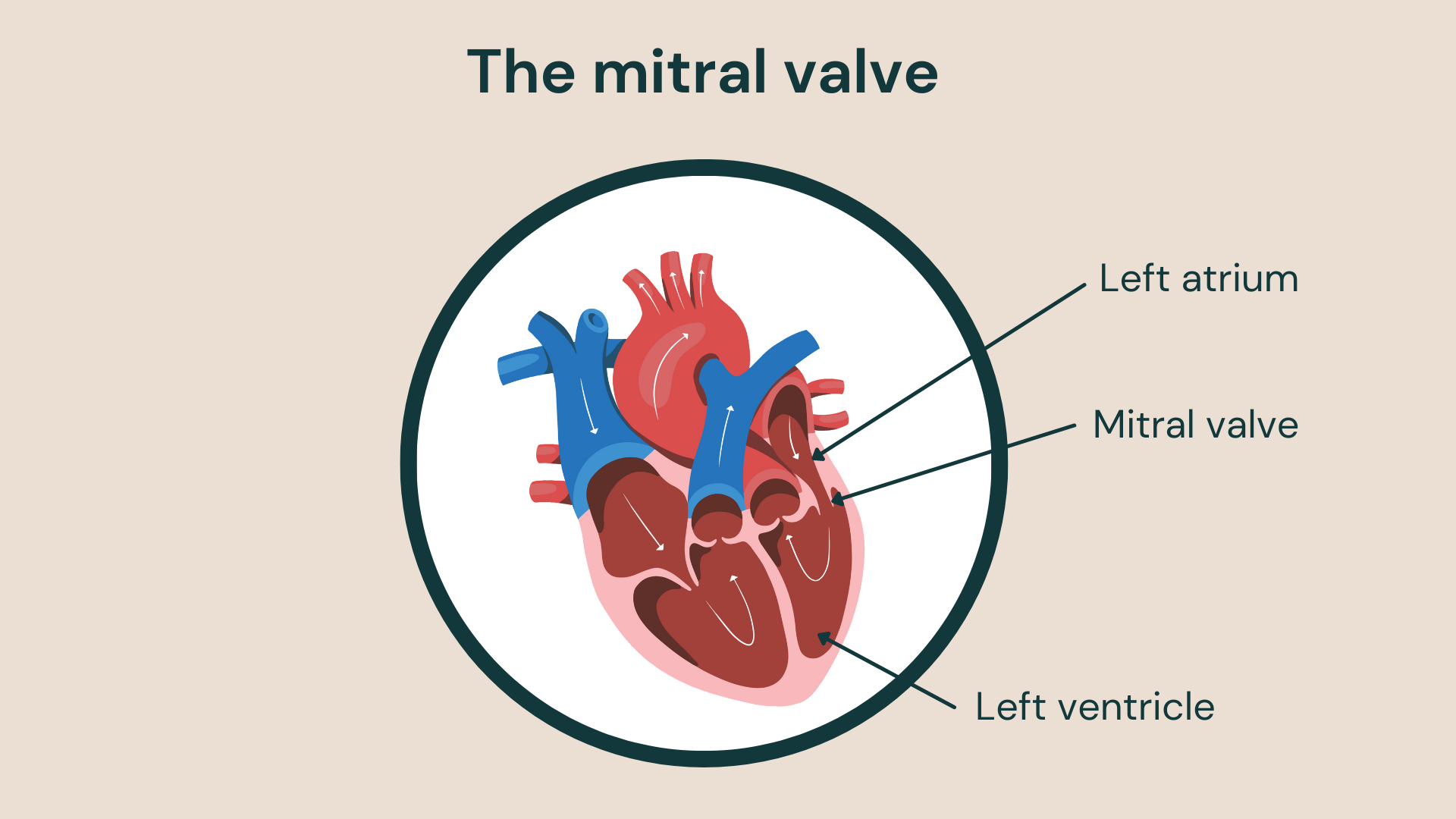In mitral valve disease, the mitral valve doesn’t work effectively. The mitral valve is the heart’s most complex valve and is one of the most vulnerable to disease. Mitral valve disease affects the blood flow through the body and puts extra strain on the heart.
Mitral valve disease can cause distressing symptoms and, if untreated, can result in serious complications, including heart failure and abnormal rhythms that can be life-threatening. However, medications can ease the symptoms, and specialist surgery can repair or replace the damaged mitral valve.
What is the mitral valve?
“The mitral valve is a small flap of tissue on the left side of your heart between the left atrium and the left ventricle. It acts as a gate between the two chambers, opening and closing as your heart beats” explains consultant cardiologist Dr Ee Ling Heng.
“The mitral valve keeps blood flowing properly through the left heart in one direction and prevents blood from flowing backwards.”
What is mitral valve disease?
Mitral valve disease occurs when the valve isn’t working properly. Mitral valve problems can affect the flow of blood through your heart and around your body. The heart has to work harder to pump enough oxygen-rich blood to supply your body’s needs, putting a strain on the organ. Mitral valve disease can cause tiredness, fluid retention and shortness of breath. However, many people with mitral valve disease have no symptoms, especially in the early stages.
For more information about symptoms, please visit our page on mitral valve disease symptoms.
There are three main types of mitral valve disease:
- mitral valve prolapse: The valve becomes floppy and bulges backwards when it closes in mitral valve prolapse
- mitral regurgitation: In mitral regurgitation, the valve becomes leaky and allows blood to flow the wrong way in the heart
- mitral stenosis: In mitral stenosis the mitral valve becomes narrowed and obstructs the flow of blood

How to diagnose mitral valve disease
“Many people with mitral valve disease don’t know they have the condition. You may have no symptoms, or the symptoms can be non-specific and attributed to other problems. However, it’s essential to pick up issues early so that you can be treated and monitored,” explains Dr Ee Ling Heng.
According to the British Heart Foundation, timely treatment is important because the risk of dying from valve disease is greater the longer the patient lives with it. It can also become severe and cause heart failure.
Experienced doctors may identify mitral valve problems by listening to your heartbeat with a stethoscope. They may hear a characteristic murmur that indicates a valve problem. They may follow up with further diagnostic tests; these could include:
Echocardiography
An echocardiogram or ‘echo’ test uses sound waves to visualise your heart. It is like an ultrasound used in pregnancy or to look at structures in the abdomen and pelvis.
An echo produces moving images of the heart and can show if the mitral valve is not opening correctly, is leaky or is bulging back into the ventricle when it closes.
An echo can help diagnose mitral valve disease, evaluate the extent of the problem and plan the best treatment.
ECG
An electrocardiogram records your heart’s rate, rhythm and electrical activity. The ECG picks up and records your heart’s electrical activity then prints it on paper. It can identify heart rhythm problems, including atrial fibrillation, which can occur in valve disease.
Transoesophageal echocardiogram
A specialist echo that better visualises the mitral valve’s structure and function. You swallow a fine tube under sedation (while you are asleep) that has an echocardiogram probe on the end. It scans the heart from inside the oesophagus, allowing closer evaluation of the mitral valve.
Mitral valve prolapse
Mitral valve prolapse is a common condition where the valve becomes floppy and doesn’t close properly. It is the most common type of mitral valve disease in industrialised nations like the UK and the USA and affects women more than men.
Mitral valve prolapse is caused by disease, damage or dysfunction of the tissues that connect the mitral valve to the cardiac muscles. Some people are born with mitral prolapse; it is more common if you have a connective tissue disorder like Marfan’s syndrome. Rarely a heart attack can damage the tissues in this area leading to mitral prolapse.
Mitral valve prolapse symptoms
If you have mitral prolapse, you may not notice any symptoms. However, it can sometimes cause dizziness, fatigue, palpitations and shortness of breath. Mitral valve prolapse can lead to mitral regurgitation in some people.
Mitral prolapse treatment
If you don’t have any symptoms, you probably will not need treatment. However, you can help your heart by having regular check-ups and making some lifestyle changes:
- stop smoking
- reduce caffeine intake
- cut back on alcohol
Making these changes can reduce the need for medication to treat your mitral valve disease. If you have symptoms, you may need treatment, which could include:
- medication to treat symptoms. Beta-blockers can help slow down an irregular heartbeat
- mitral valve repair
- mitral valve replacement
Mitral valve regurgitation
In mitral regurgitation, the mitral valve becomes leaky and allows blood to flow the wrong way in the heart. It occurs when the valve doesn’t close properly when the left ventricle contracts to pump blood around the body. Blood leaks, or regurgitates, back into the atrium.
Common causes of mitral regurgitation are mitral prolapse, damage by rheumatic fever, heart attack and valve infections. It can also develop if the heart’s left ventricle is enlarged due to chronic hypertension or alcohol abuse. Mitral regurgitation can also occur in children as a result of congenital abnormalities.
Mitral regurgitation often develops gradually. However, it can come on suddenly and severely if, for example, one of the tissue tendons that attach the valve to the heart wall snaps. If this happens, you may become acutely unwell and need emergency surgery to replace the damaged valve.
Mitral valve regurgitation symptoms
If you have mitral regurgitation, you may not notice any symptoms. However, it can sometimes cause:
- dizziness
- chest pain
- fatigue
- palpitations
- shortness of breath
Mitral valve regurgitation treatment
If you don’t have any symptoms, you probably will not need treatment for your mitral regurgitation. If you have symptoms, you may need treatment, which could include:
- medication to treat symptoms. Beta-blockers can treat atrial fibrillation, diuretics can reduce excess fluid in the body and treat breathlessness, and a range of hypertension medications can lower blood pressure
- mitral valve repair
- mitral valve replacement
- percutaneous mitral valve repair: Minimally invasive surgery such as MitraClip in which the specialist introduces a fine, flexible tube into a blood vessel in your groin. They pass it to the heart using X-ray guidance and attach a clip to the mitral valve to help it close properly
Mitral valve stenosis
In mitral stenosis, the mitral valve becomes narrowed and obstructs the blood flow. Mitral stenosis is the most common type of valve disease worldwide due to rheumatic fever infection.
Rheumatic fever develops following a streptococcal infection in the throat. The infection can spread and scar the mitral valve, narrowing it and increasing the risk of calcium deposits that make the valve stiff. The wide availability of antibiotics in industrialised nations has dramatically decreased the incidence of mitral stenosis in countries like the UK.
“In developing countries, mitral stenosis is still relatively common. It particularly affects young women, sometimes coming on in pregnancy when there are extra demands on the heart. You can also develop mitral stenosis if the valve gets stiff with calcified deposits as a result of age, and children may be born with mitral valve problems,” explains Dr Ee Ling Heng.
Mitral valve stenosis symptoms
If you have mitral stenosis, you may not notice any symptoms. However, it can cause:
- dizziness
- fatigue
- chest pain
- palpitations
- shortness of breath
- sometimes coughing up blood
Mitral valve stenosis treatment
If you don’t have any symptoms, you may not need treatment for your mitral stenosis. If you have symptoms, you may need treatment, which could include:
- medication to treat symptoms. Digoxin can treat atrial fibrillation, diuretics can reduce excess fluid in the body and treat breathlessness, a range of hypertension medications can lower blood pressure and beta-blockers can slow down your heart rate so that there is more time for the atrium of the heart to empty
- balloon valvuloplasty: This minimally invasive procedure can relieve the blockage if the valve is not too stiff. The specialist introduces a fine, flexible tube into a blood vessel in your groin. They pass it to the heart using X-ray guidance
- mitral valve repair
- mitral valve replacement
Get in touch
Learn more about available treatments for mitral valve disease, and how our cardiology specialists can help, by contacting our customer services team.
Related content
-
Cardiac surgery
Our consultants are at the forefront of cardiac surgery, pioneering a range of minimally invasive procedures.
-
Cardiology
Our specialists are continuously innovating in minimally invasive cardiology procedures and improving care delivery.
-
Heart screening
Heart screening service offering a range of diagnostic tests that help us check for underlying heart problems at the earliest stages.
-
Mitral regurgitation
Mitral regurgitation is the most common heart valve problem worldwide. It is a dysfunction of the heart’s mitral valve.
-
Heart valve repair or replacement
Heart valve surgery can repair or replace a damaged valve.
-
Valvular heart disease
Heart valve disease occurs when the valves of the heart become diseased or damaged.
